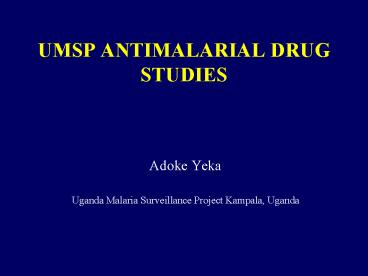UMSP ANTIMALARIAL DRUG STUDIES - PowerPoint PPT Presentation
1 / 21
Title:
UMSP ANTIMALARIAL DRUG STUDIES
Description:
Genotyping was done to distinguish recrudescence from new infections ... AQ AS lowered risk of recrudescence ... the risk of recrudescence between AQ SP and ... – PowerPoint PPT presentation
Number of Views:63
Avg rating:3.0/5.0
Title: UMSP ANTIMALARIAL DRUG STUDIES
1
UMSP ANTIMALARIAL DRUG STUDIES
- Adoke Yeka
- Uganda Malaria Surveillance Project Kampala,
Uganda
2
Introduction
- Malaria control in Africa largely relies on
effective case management. - This effort is compromised by the rapidly
increasing resistance to the cheap and widely
used drugs CQ and SP. - Use of ACTs is strongly advocated, but concerns
remain regarding cost and availability. - There is limited comparative data on the efficacy
and safety of ACTs in Africa.
3
Objectives
- Compare the efficacy of combination regimens
- for the treatment of uncomplicated malaria at
- multiple sites in Uganda
- CQ SP
- AQ SP
- AQ AS
4
Study Methodology
- Randomized, single blinded, clinical trials at 7
sites with varying transmission intensity around
Uganda - Patient were followed up for 28-days
- Genotyping was done to distinguish recrudescence
from new infections - There were 2 comparative study designs
- 2-arm studies CQ SP vs. AQ SP
- 3-arm studies CQ SP vs. AQ SP vs. AQ AS
5
Study Methodology
- Inclusion criteria
- Age gt 6 months
- Fever or history of fever in past 24 hours
- P. falciparum mono-infection
- Parasite density 2000/µl 200,000/µl
- No severe disease or other febrile illness
- Patients were randomised to receive
- CQ (25 mg/kg over 3 days) plus SP (25 mg/kg
sulfadoxine, 125 mg/kg pyrimethamine, single
dose) - AQ (25 mg/kg over 3 days) plus SP
- AQ plus AS (4 mg/kg daily for 3 days).
- All treatment was directly observed.
6
Assessment of Treatment Efficacy
- Outcomes classified according to 2003 WHO
guidelines - Early treatment failure (ETF)
- Late clinical failure (LCF)
- Late parasitological failure (LPF)
- Adequate clinical and parasitological response
(ACPR) - Risk of recurrent parasitemia (unadjusted by
genotyping) - Proportion of patients with ETF, LCF or LPF
- Risk of recrudescence (adjusted by genotyping)
- Risk of ETF or LCF/LPF due to recrudescent
parasites using Kaplan-Meier product limit
formula (new infections censored)
7
BASELINE CHARACTERISTICS
8
KANUNGU SITERisk of treatment failure
Recrudescence
Recurrent Parasitemia
9
MUBENDE SITERisk of treatment failure
Recrudescence
Recurrent Parasitemia
10
KYENJOJO SITERisk of treatment failure
Recrudescence
Recurrent Parasitemia
11
Summary of 2 arm studies
- Risk of recurrent parasitemia after 28 days is
alarmingly high, underscoring the impact of new
infections on antimalarial drug efficacy in
Africa - Risk of failure with CQ SP is alarmingly high
in Uganda - AQ SP was much more efficacious than CQ SP
- AQ SP greatly reduces the risk of recurrent
parasitaemia. - AQ SP greatly reduces the risk of recrudescence.
12
JINJA SITERisk of treatment failure
Recrudescence
Recurrent Parasitemia
13
APAC SITERisk of treatment failure
Recrudescence
Recurrent Parasitemia
14
TORORO SITERisk of treatment failure
Recrudescence
Recurrent Parasitemia
15
ARUA SITERisk of treatment failure
Recrudescence
Recurrent Parasitemia
16
Summary of 3 arm studies
- Risk of recurrent parasitemia after 28 days is
alarmingly high. - New infections have a big impact on recurrent
parasitemia even with ACT regimens. - CQ SP is failing badly in Uganda
- AQ SP or AQ AS are much more efficacious
- AQ AS lowered risk of recrudescence
- AQ SP lowered risk of recurrent parasitemia,
especially at the sites with the highest
transmission intensity - There is minimal difference in the risk of
recrudescence between AQ SP and AQ AS
17
AQAS vs AL STUDY
- Study conducted at Tororo in 2004 - 5 to assess
efficacy and safety of proposed 1st line ACT
regimens in Uganda. - Randomised single blinded trial with 28 day
follow up. - Micro-satellites used for genotyping
- Recruited 200 patients per treatment arm
- Recruitment criteria similar for previous studies
except - Age 1-10 years
- Weight gt 10 kg.
- Directly observed therapy (6 dose for AL)
18
TORORO SITERisk of treatment failure
Recrudescence
Recurrent Parasitemia
19
Conclusion
- Risk of treatment failure with CQ SP was
unacceptably high at all sites - AQ SP was much more efficacious than CQ SP
- AL and AQAS were highly efficacious
- For both ACT regimens, the high rate of
re-infection and the implications of frequent
retreatment are a major concern. - High malaria endemicity in Africa may impact on
effectiveness of ACTs. - For ACTs to be maximally effective, they may need
to be combined with measures aimed to reduce
transmission intensity
20
Future studies.
- Efficacy and safety of ACTs (AL, DP, CDA etc)
- Efficacy and effectiveness of quinine as second
line drug for uncomplicated malaria. - Study deployment of ACTs
- Health facility vs HBMF
- Use of RDTs
- Pharmacovigilance for safety
21
Thank You





















![The acceptability of illicit drug use in the Netherlands and Norway: a comparative study [preliminary results] PowerPoint PPT Presentation](https://s3.amazonaws.com/images.powershow.com/8579999.th0.jpg?_=20170308115)









